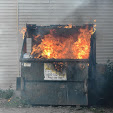In the late 1930s, Imperial Japan's ongoing invasion of China was beginning to place a strain on the ability of her arsenals to keep the army supplied with rifles. With the army taking all the rifle production from home, the navy was forced to go shopping for a source of rifles for their naval infantry. A call to their new Axis partner, Italy, resulted in one of the more unusual military rifles of WWII.
 ABOVE: Japanese Type I rifle. Photo by Oleg Volk.
ABOVE: Japanese Type I rifle. Photo by Oleg Volk.
The new rifle, referred to as the "Type I", was a hybrid of Italian and Japanese features. (
Sort of like ramen al dente,
or a teriyaki beef calzone. Mmmm. Anyway...) The rifle's action was that of the Mo. 1891 Carcano, which itself was a more-or-less direct ripoff of the old
Gew.88 "Commission Rifle", sans the usual Mannlicher-style magazine. In its place was a Mauser-type box magazine that could be fed rounds from stripper clips. The rifle was chambered for the standard Japanese 6.5x50mm cartridge, and the furniture and sights were pure Arisaka, down to the two-piece dovetailed buttstock. Unlike other Japanese service rifles, they were not marked with the Imperial chrysanthemum on the receiver ring. In fact, except for the serial number and various small proof marks, they were remarkably devoid of markings of any sort.
Never common on the US collector scene (less than 60,000 were produced; compared to millions for most other WWII service rifles) it's possible to go many years without ever seeing one at a store or gun show. It's not listed in the
Blue Book or the
Standard Catalog of Military Firearms. It's mentioned but not pictured in
Japanese Rifles of World War II and Scarlata's
Bolt Action Military Rifles book. At the previous gun store I worked at, an old guy walked in the door with a long rifle in tow:
"
Hey, I got this ol' military rifle. A buddy of mine tol' me that this lady that works here knows a lot about ol' army guns, collects 'em, even, and could tell me what it's worth."
"That'd be me."
As he started to heave the rifle up onto the counter, saying "
I think it's Japanese...", I heroically kept from squeaking "Ohmigod! It's a
Type "I"!" I'd never seen one in the steel before.
"
So, what's it worth?"
"Well, sir, it's hard to say. The gun isn't in any of the usual price guides. Obscurity may work against it, the bore is a nasty dark orange with corrosion, and ammo is so expensive that an empty magazine means the gun's nearly totalled. On the other hand, it's cosmetically nice, and someone who knows what it is and is just dying to have one for their collection may be willing to pay well to get it. What do you figure you need to get out of it?"
"
Well, I'd like to get out of it what I've got in it..."
"Which is? If you don't mind me asking..."
"
Naw. I paid $75 for it, and I reckon I've got $5 worth of my time in running it over here. How's $80 sound?"
"Let me call my boss."
I walked in the back room and rang him on the cell phone. Bear in mind my boss at that shop didn't know one milsurp from another. To him, they're all just junky old rifles.
"Hey, I've got this guy that wants to sell us a Type I." *
long pause* "It's a rifle with Arisaka-style parts on a
Carcano action." *
longer pause* "Anyhow, it's an oddball old Japanese rifle. He wants $80 for it."
"
I dunno, money's still kinda tight right now. You think we could sell it for $150?"
"Hell ye... er, I mean, I know somebody who'd pay $150 for it."
"
Who?"
"Me!"
"
Okay, give him $80."
Back out front.
"Here you go, sir."
"
Thank you very much, ma'am; if I find anything else, I'll let you know."
Later, my boss apparently decided that he could live with making only a $50 profit off me, instead of a $70 one, which was just fine with me. The rifle in question turned out to be one that was produced at Beretta, rather than one of the more common government arsenal-produced specimens. Ammunition is still produced by Norma, but at today's prices, two and a half boxes actually equal what I paid for the rifle, so until I get dies in the caliber, it won't get shot much. Whether it gets shot or not, it's an interesting artifact from WWII and makes for quite the conversation piece.








